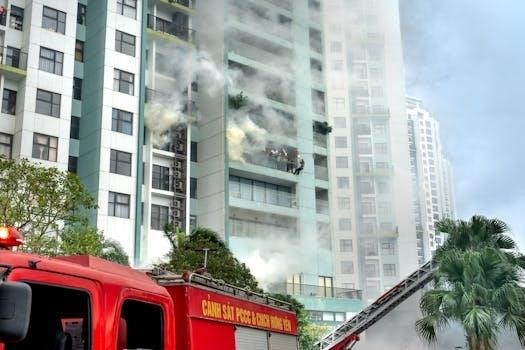The Incident Response Pocket Guide (IRPG) is a crucial resource establishing standards for wildland fire incident response․ This guide offers vital information on best practices․ It also serves as a job aid and training reference for operational personnel, including firefighters and incident commanders․ The IRPG is a collection of guidelines, checklists, and best practices that have evolved over time within the wildland fire service․
Purpose of the IRPG
The primary purpose of the Incident Response Pocket Guide (IRPG) is to furnish a readily accessible, concise reference for wildland fire personnel, ranging from Firefighter Type 2 through Division Supervisor and initial attack/extended attack Incident Commanders․ This guide serves as a vital job aid, offering essential information and standardized procedures for effective incident response․ It aims to enhance the safety and efficiency of operations by providing a collection of best practices that have been refined over time․ The IRPG also facilitates consistent application of these best practices across different incidents and among various teams․ By standardizing approaches to operational engagement, risk management, and all-hazard response, the guide ensures that personnel have a reliable framework for making sound decisions in dynamic, high-pressure environments․ The guide’s overarching goal is to improve the overall effectiveness of incident response through a shared understanding of procedures and protocols․

Key Areas Covered in the IRPG
The IRPG encompasses key areas including operational engagement, risk management, fire environment awareness, all-hazard response protocols, and aviation management guidelines․ These sections provide critical information and support for incident response․
Operational Engagement
Operational engagement within the Incident Response Pocket Guide (IRPG) focuses on the practical application of strategies and tactics during an incident․ It emphasizes clear communication, effective coordination, and the implementation of established protocols․ This section provides guidance on how personnel should interact with each other and the incident environment, ensuring that actions are aligned with the overall incident objectives․ It includes checklists and procedures for various operational tasks, supporting consistent and safe practices․ Furthermore, it addresses the importance of situational awareness and adaptability, acknowledging that incident conditions can change rapidly․ The IRPG promotes a unified approach to incident management by setting forth standards for communication, command, and control, aiming to improve operational effectiveness․ This crucial section of the IRPG helps to maintain a safe and efficient response․
Risk Management
The Risk Management section of the Incident Response Pocket Guide (IRPG) is dedicated to identifying, assessing, and mitigating potential hazards during an incident response․ This critical component emphasizes the importance of proactive risk assessment to ensure the safety of all personnel involved․ It provides guidelines for evaluating various risks, including environmental factors, operational activities, and human error․ The IRPG offers strategies and tools to help incident managers implement appropriate risk control measures, aiming to minimize potential negative impacts․ It highlights the need for continuous monitoring and reassessment as conditions change, promoting a dynamic risk management approach․ This section includes checklists and procedures to facilitate informed decision-making and maintain a safe operating environment, underlining the IRPG’s commitment to safety․ Effective risk management is crucial for a successful incident response․
Fire Environment
The Fire Environment section of the Incident Response Pocket Guide (IRPG) focuses on understanding the dynamic factors influencing fire behavior․ This section emphasizes the importance of assessing fuels, weather conditions, and topography to predict fire spread and intensity․ The IRPG provides guidance on recognizing critical fire environment indicators, such as fuel moisture content, wind direction and speed, and terrain features․ It stresses the need for continuous monitoring of these factors, as they can significantly impact fire behavior and influence tactical decisions․ This section includes checklists and tools to assist personnel in evaluating the current fire environment and anticipating potential changes․ It highlights the importance of using this information to develop effective strategies and ensure responder safety․ A thorough understanding of the fire environment is crucial for successful incident management․ This section is vital for operational personnel involved in wildland fire response․
All Hazard Response
The All Hazard Response section of the Incident Response Pocket Guide (IRPG) extends the guide’s applicability beyond wildland fires to include various incident types․ This section provides a framework for responding to diverse emergencies, such as vehicle accidents, hazardous materials incidents, and search and rescue operations․ It emphasizes the importance of a standardized approach to incident management, regardless of the specific hazard․ The IRPG offers checklists and guidelines that can be adapted for use in different scenarios․ It focuses on maintaining a safe and organized response, addressing incident objectives, and ensuring effective communication between all personnel involved․ This section also highlights the need for adaptability and flexibility in responding to different emergencies․ It promotes a unified approach, emphasizing interagency cooperation and coordination to achieve successful outcomes in all hazard situations․ The IRPG serves as a valuable tool for personnel involved in various types of emergency response․

Aviation Management
The Aviation Management section within the Incident Response Pocket Guide (IRPG) is dedicated to ensuring safe and effective aerial operations during incident response․ This section addresses the complexities of using aircraft for various tasks, including reconnaissance, personnel transport, and aerial firefighting․ It provides crucial guidelines for aviation resource coordination, risk assessment, and operational procedures․ The IRPG outlines communication protocols, safety checklists, and emergency procedures for aircrews and ground personnel․ It emphasizes the importance of clear communication channels, proper aircraft staging, and adherence to established aviation safety standards․ This section also includes information on managing aviation mishaps; It provides checklists for initiating a response and mitigating potential risks․ The IRPG promotes a coordinated approach to aviation management․ It stresses the need for all personnel to understand their roles and responsibilities․ This section aims to minimize the risk of aviation accidents and enhance the overall effectiveness of aerial operations․

IRPG Details and Updates
This section provides information regarding the Incident Response Pocket Guide (IRPG) publication details, including the publication date, and the National Fire Equipment System (NFES) number․ It also offers a summary of the 2022 updates․
Publication Information
The Incident Response Pocket Guide, often referred to as the IRPG, is identified by the publication number PMS 461 and the National Fire Equipment System (NFES) number 001077․ The current publication date for the IRPG is January 2022․ The previous edition of this crucial guide was released in April 2018․ The next revision of the IRPG is scheduled for 2026, ensuring that the information remains current and relevant․ This document is officially sponsored for NWCG publication by the NWCG Operations and is a crucial resource for wildland fire personnel․ The IRPG is available in PDF format for easy access and printing․ Additionally, the PDF version includes options for printing with either an orange or a white background, catering to different preferences and visibility needs․ It is a key document for those involved in incident response․
2022 Updates Summary
The 2022 revision of the Incident Response Pocket Guide (IRPG) included several significant updates to enhance its usability and relevance․ One notable addition is the inclusion of a ruler on the inside of the front cover, providing a handy tool for field measurements․ Furthermore, a mental health checklist was incorporated into the guide, recognizing the importance of mental well-being for personnel involved in incident response․ These updates reflect the evolving needs and priorities within the wildland fire service․ The 2022 edition ensures that the IRPG remains a current and valuable resource․ The updates aim to provide practical tools and support for those using the guide in the field; These additions demonstrate a commitment to improving both operational effectiveness and the well-being of personnel․ The changes make it a more comprehensive tool․

Target Audience and Application
The IRPG is designed for wildland fire operational personnel, from Firefighter Type 2 to Division Supervisor․ It also applies to initial and extended attack Incident Commanders and has a secondary use for all-hazard incident response․
Intended Users
The primary audience for the Incident Response Pocket Guide (IRPG) encompasses a wide range of personnel involved in wildland fire management and incident response․ This includes, but is not limited to, firefighters at various levels, such as Firefighter Type 2, who are directly engaged in fire suppression activities․ Furthermore, the guide is intended for use by supervisory personnel like Division Supervisors, who oversee specific operational areas within an incident․ Incident Commanders, both those managing initial attack efforts and those handling extended attack incidents, also form a core part of the intended user base․ These individuals are responsible for strategic decision-making and overall incident management․ The IRPG serves as a quick reference for all these roles, providing essential information to support safe and effective response operations and ensuring that all involved personnel have access to standardized best practices․ The guide supports their understanding of incident management protocols․
Secondary Application
While the Incident Response Pocket Guide (IRPG) is primarily designed for wildland fire incidents, its secondary application extends to all-hazard incident response․ The principles and procedures outlined in the IRPG are adaptable to a variety of emergency situations beyond wildfires․ This includes incidents such as vehicle accidents, hazardous materials (HazMat) events, and search and rescue operations․ The guide’s focus on operational engagement, risk management, and incident command structure provides a valuable framework for managing any emergency scenario․ The checklists, guidelines, and best practices can be utilized to ensure a coordinated and effective response․ By embracing a broader application, the IRPG enhances the preparedness of personnel involved in a variety of emergencies․ This adaptability helps to promote a consistent and efficient response across different types of incidents, making the IRPG a versatile resource for diverse emergency management scenarios․ The guide’s structure can be readily applied to various response efforts․